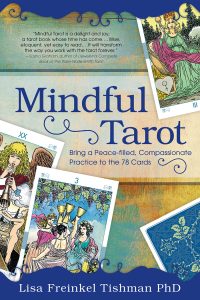Mindful Tarot

Author Lisa Freinkel Tishman, PhD, brings us a new way to work with and think about our cards. You can find out more about her book HERE. She explains the difference between mantic tarot and mindful tarot in this excerpt:
“Mantic” Tarot
In a recent blog post, Tarot expert Mary K. Greer quotes educator Parker Palmer’s famous dictum: “Wholeness does not mean perfection: it means embracing brokenness as an integral part of life.” She goes on to challenge the Tarot community:
Many people come to Tarot readings in hopes of “fixing” their lives—obtaining information and guidance that will help them make the “right” decisions and no mistakes—guaranteeing perfection. I ask you, as a Tarot reader, how can we help the querent “embrace brokenness”?
My challenge in this book takes Greer’s (and Palmer’s) point even further: how can we help the querent, the Seeker – how can we help ourselves— embrace our fundamental unbrokenness?
The majority of Tarot readers today focus on the work of inner transformation and self-realization. But even so, most readers are still bound within the confines of what I call “mantic Tarot”: the Tarot of prediction and prophecy. (Mantic, as used in terms like cartomancyor geomancy, comes from the ancient Greek word mantis, or “prophet.”) We may be reading with an aim toward personal growth instead of old-fashioned fortune telling, but nonetheless we typically begin with a problem or a question. Something is broken, missing or inadequate. We may not be seeking our fortune or our future, but we nevertheless begin with a sense that something is wrong. What I call “mantic Tarot” seeks solutions. Mantic Tarot sets out from the standpoint of lack and dissatisfaction. Mantic Tarot begins by looking elsewhere, seeking elusive meaning and shrouded answer. Mantic Tarot is fixated on the future, and often stuck in the past.
All of this is very natural, and very ancient. The mantic impulse is probably as old as human written language itself. As long as we humans have been readers and writers, using visual symbols to record and convey our ideas, we have no doubt felt the urge to interpret naturally arising phenomena – the structure of entrails or bone remaining from an animal sacrifice; the wheeling constellations in the night sky; the pattern of dregs left in a cup — as if these too comprised a written language, a text that could be interpreted and obeyed. We grant meaning and intention to the random occurrences of our world. Psychologist and Tarot author Arthur Rosengarten refers, in this light, to our drive toward an “empowered randomness.” We grant a non-human world the power to speak.
Mindfulness… and Tarot
In a mindfulness class, the inquiry is where integration and insight begin to take place. Inquiry can also be the occasion for joy, laughter and community.
Inquiry forms a crucial component of Mindful Tarot as well. Mindfulness practice requires the clarity and precision of inquiry. Like a good wine connoisseur, we need ways to observe and articulate nuance. With its deeply rich vocabulary of archetypes and images, Tarot invites us into a finely-tuned interpretive practice. We may think that the cards respond to the questions we ask, but the practice of Mindful Tarot reveals that the reverse is actually more accurate. When we spread out the Tarot, it is we who are responding to the questions posed by the cards.
First and foremost, Mindful Tarot is a practice of inquiry. It is a deep dialogue with the cards and a thorough investigation of this present moment. Through the language of the cards, Mindful Tarot helps us “pay attention on purpose, in the present moment, non-judgmentally.”









